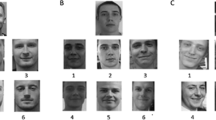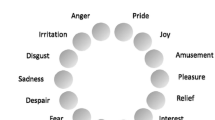Abstract
The Penn Facial Discrimination Task (PFDT) is an emotion recognition instrument consisting of a series of monochrome facial photographs of adults (Erwin et al., 1992). In addition to the emotion task, the PFDT also has a control task, in which the subject has to estimate the approximate age of the depicted person. In previous studies, the PFDT has been shown to be a valid instrument for subjects with psychiatric disorders, and it has also generated useful results in populations with mental retardation. This study was designed to explore the applicability of the PFDT in subjects with borderline cognitive functioning and mental retardation (N=105; IQs ranging from 23 to 81). Data were analyzed to generate preliminary normative data for different subgroups of adults with mental retardation (sex, IQ-levels, and lateral dominance). In addition, item analyses were conducted and psychometric properties including retest reliability, internal consistency, item-subscale correlations, concurrent validity, and content validity were examined. The PFDT was found to be a feasible experimental task for emotion recognition research in groups of subjects with mental retardation.
Similar content being viewed by others
References
Aman, M. G. (1991).Assessing psychopathology and behavior problems in persons with mental retardation: A review of available instruments, U.S. Department of Health and Human Services, Rockville, MD.
BMDP Statistical Software Inc. (1990)BMDP Statistical Software, Author, Los Angeles, CA.
Brody, L. R., and Hall, J. A. (1993). Gender and emotion. In M. Lewis and J. M. Haviland (eds.),Handbook of Emotions, pp. 447–460.
Brosgole, L., Kurucz, J., PlaHovinsak, T. J., Sprotte, C., and Haveliwala, Y. (1983). Facial and postural affect recognition in senile elderly persons.Int. J. Neurosci. 22: 37–46.
Engen, T., Levy, N., and Schlosberg, H. (1958). The dimensional analysis of a new series of facial expressions.J. Exp. Psychol. 55: 454–458.
Ekman, P., and Friesen, W. V. (1975).Unmasking the Face. A Guide to Recognizing Emotions from Facial Cues, Prentice Hall, Cliffs, N.J.
Erwin, R. J., Gur, R. C., Gur, R. E., Skolnick, B., Mawhinney-Hee, M., and Smailis, J. (1992). Facial emotion discrimination: I. Task construction and behavioral findings in normal subjects.Psychiatry Res. 42: 231–240.
Gray, J. M., Fraser, W. L., and Leudar, I. (1983). Recognition of emotion from facial expression in mental handicap.Br. J. Psychiatry 142: 566–571.
Gur, R. C., Erwin, R. J., Gur, R. E., Zwil, A. S., Heimberg, C., and Kraemer, H. C. (1992). Facial emotion discrimination: II. Behavioral findings in depression.Psychiatry Res. 42: 241–251.
Heimberg, C., Gur, R. E., Erwin, R. J., Shtasel, D. L., and Gur, R. C. (1992). Facial emotion discrimination: III. Behavioral findings in schizophrenia.Psychiatry Res. 42:253–265.
Hobson, R. J., Ouston, J., and Lee, A. (1989). Recognition of emotion by mentally retarded adolescents and young adults.Am. J. Ment. Retard. 93: 434–443.
Izard, C. D. (1983).The Maximally Discriminative Facial Movement Coding System (rev. ed.), Instructional Resource Center, University of Delaware, Newark, DE.
Izard, C. E., Dougherty, L. M., and Hembree, A. A. (1983).A System for Identifying Affect Expressions by Holistic Judgements (Affex), Instructional Resource Center, University of Delaware, Newark, DE.
Masters, J. C., Barden, R. C., and Ford, M. E. (1979). Affective states, expressive behavior, and learning in children.J. Personal. Social Learning 33: 380–390.
McAlpine, C., Kendall, K. A., and Singh, N. N. (1991). Recognition of facial emotion by persons with mental retardation.Am. J. Ment. Retard. 96: 29–36.
McAlpine, C., Singh, N. N., Kendall, K. A., and Ellis, C. (1992). Recognition of facial expressions of emotion by persons with mental retardation: A matched comparison study.Behav. Mod. 16: 543–558.
Morris, R. D., and Romski, M. A. (1993). Handedness distribution in a nonspeaking population with mental retardation.Am. J. Ment. Retard. 97: 443–448.
Reed, J., and Clements J (1989). Assessing the understanding of emotional states in a population of adolescents and young adults with mental handicaps.J. Ment. Def. Res. 33: 229–233.
Reitan, R. M., and Davison, L. (1974).Clinical Neuropsychology: Current Status in Applications, Winston, Washington, D.C.
Robinson, R. G., and Starkstein, S. E. (1990). Current research in affective disorders following stroke.J. Neuropsychiatry Clin. Neurosci. 2:1–14.
Rojahn, J., Kroeger, T. J., and McElwain, D. C. (1994). Performance on the Penn Facial Discrimination Task by adults with mental retardation.Am. J. Ment. Retard. 99: 316–319.
Rojahn, J., Rabold, D. E., and Schneider, F. (1995). The emotion specificity hypothesis in adults with mental retardation.Am. J. Ment. Retard. 99: 477–486.
SAS Institute Inc. (1989).SAS User's Guide: Statistics, Authors, Cary., N.C.
Sattler, J. M. (1992).Assessment of children (third edition). Authors San Diego.
Wilkinson, L., Hill, M. A., Welna, J. P. and Birkenbeutel, G. K. (1992),SYSTAT for Windows (vers. 5), SYSTAT Inc. Evanston, IL.
Winer, B. J. (1962).Statistical Principles in Experimental Design, McGraw Hill, New York, N.Y.
Author information
Authors and Affiliations
Rights and permissions
About this article
Cite this article
Rojahn, J., Kroeger, T.L. & McElwain, D.C. Psychometric properties and preliminary norms of the penn facial discrimination task in adults with mental retardation. J Dev Phys Disabil 7, 285–301 (1995). https://doi.org/10.1007/BF02578432
Issue Date:
DOI: https://doi.org/10.1007/BF02578432




